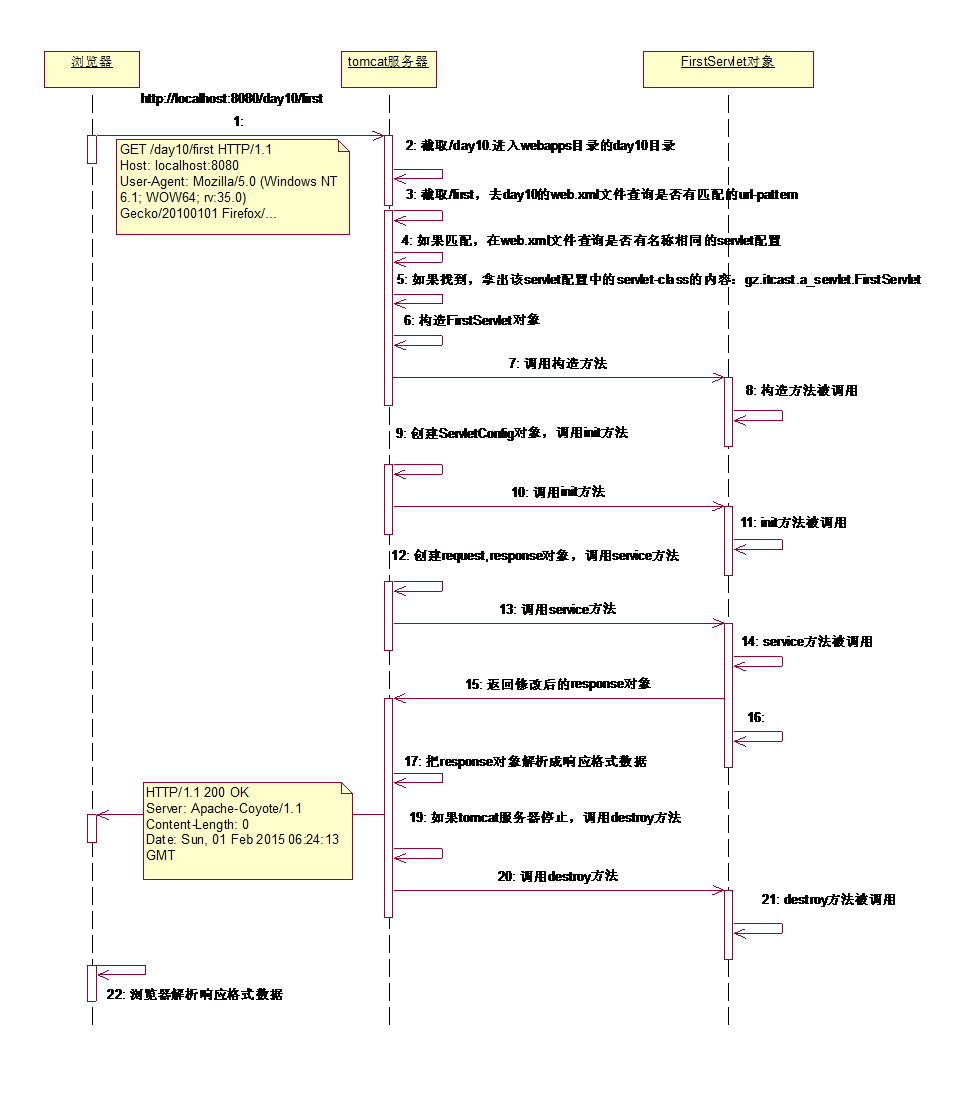Servlet的生命周期
Posted Ran959
tags:
篇首语:本文由小常识网(cha138.com)小编为大家整理,主要介绍了Servlet的生命周期相关的知识,希望对你有一定的参考价值。
Servlet的生命周期
servlet的生命周期顾名思义就是从servlet出现到消亡(销毁)的全过程。
主要分为以下几个阶段:
加载类—>实例化(为对象分配空间)—>初始化(为对象的属性赋值)—>请求响应(服务阶段)—>销毁
servlet生命周期三个方法:
init()初始化阶段
service()处理客户端请求阶段
destroy()终止阶段
容器(tomcat等)装载servlet
实例化阶段
1.1 当客户端首次发送第一次请求后,由Servlet容器去解析请求,根据请求找到是否有对应的servlet。
1.2 判断是否有Servlet实现类的对象存在?存在则直接使用,不存在则先创建一个servlet实现类的对象。
初始化阶段
Servlet 初始化是其生命周期的第一个阶段,也是其他阶段的基础。只有完成了初始化,Servlet 才能处理来自客户端的请求。
Servlet 初始化阶段分为 2 步:
- 加载和实例化 Servlet;
- 调用 init() 方法进行初始化
1.加载和实例化
Servlet 容器负责加载和实例化 Servlet。
当容器启动或首次请求某个 Servlet 时,容器会读取 web.xml (配置load-on-startup=1,默认为0)或 @WebServlet 中的配置信息,对指定的 Servlet 进行加载。加载成功后,容器会通过反射对 Servlet 进行实例化。
2.调用 init() 方法进行初始化
加载和实例化完成后,Servlet 容器会创建一个servlet对象并调用servlet的init方法(在servlet生命周期内只能调用一次init方法)去初始化 Servlet 实例。
请求响应阶段
初始化完成后调取service()方法,由service()判断客户端的请求方式。
3.1 如果是get请求,则执行doGet()方法。
3.2 如果是post请求,则执行doPost()。
3.3 处理方法完成后会作出相应的结果返回给客户端,单次请求处理完毕。
当用户发送第二次以后的请求时,会判断对象是否存在,但是不再执行init(),而直接执行service方法调取doGet() / doPost()方法。
服务终止阶段
当服务器关闭,重启或移除 Servlet 实例时Servlet调取destroy()方法进行销毁,宣告生命周期的结束。
public class EmpServlet extends HttpServlet
//初始化servlet,调用init方法
public void init() throws ServletException
System.out.println("初始化时调用");
//开启服务
protected void service(HttpServletRequest arg0, HttpServletResponse arg1) throws ServletException, IOException
System.out.println("开启服务时调用");
protected void doGet(HttpServletRequest req, HttpServletResponse resp) throws ServletException, IOException
//销毁时调用destory
public void destroy()
System.out.println("销毁时调用");
Servlet编程:Servlet的生命周期
4、Servlet的生命周期
4.1、引入
Servlet的生命周期涉及3个问题: servlet类对象什么时候创建,什么时候调用什么方法,什么时候销毁。
以前的对象,其生命周期由程序开发者编写决定,例如:
Student stu = new Student();//创建Student对象
stu.study();//调用方法
stu = null;//告诉垃圾回收器GC,该对象可以进行回收了
Servlet程序的生命周期由tomcat服务器控制的!!!!
4.2、Servlet生命周期的四个重要方法
| 序号 | 方法 | 调用时机和次数 |
|---|---|---|
| 1 | 构造方法 | 创建servlet对象的时候调用。默认情况下,第一次访问servlet的时候创建servlet对象只调用1次。servlet对象在tomcat是单实例的。 |
| 2 | init方法 | 创建完servlet对象的时候调用。只调用1次。 |
| 3 | service方法 | 每次发出请求时调用。调用n次。 |
| 4 | destroy方法 | 销毁servlet对象的时候调用。停止服务器或者重新部署web应用时销毁servlet对象。只调用1次。 |
案例:验证Servlet生命周期的4个重要方法的调用次数
LifeDemo.java
package com.rk.http.b_lifecycle;
import java.io.IOException;
import javax.servlet.ServletConfig;
import javax.servlet.ServletException;
import javax.servlet.ServletRequest;
import javax.servlet.ServletResponse;
import javax.servlet.http.HttpServlet;
public class LifeDemo extends HttpServlet
{
//1、构造方法
public LifeDemo()
{
System.out.println("1、LifeDemo对象被创建!");
}
//2、init方法
@Override
public void init(ServletConfig config) throws ServletException
{
System.out.println("2、调用LifeDemo对象的init方法");
}
//3、service方法
@Override
public void service(ServletRequest req, ServletResponse res) throws ServletException, IOException
{
System.out.println("3、调用LifeDemo对象的service方法");
}
//4、destroy方法
@Override
public void destroy()
{
System.out.println("4、LifeDemo对象销毁");
}
}web.xml配置
<servlet> <servlet-name>LifeDemo</servlet-name> <servlet-class>com.rk.http.b_lifecycle.LifeDemo</servlet-class> </servlet> <servlet-mapping> <servlet-name>LifeDemo</servlet-name> <url-pattern>/life</url-pattern> </servlet-mapping>
使用URL(http://localhost:8080/myweb/life)访问5次后,停止Tomcat,得到如下输出:
1、LifeDemo对象被创建! 2、调用LifeDemo对象的init方法 3、调用LifeDemo对象的service方法 3、调用LifeDemo对象的service方法 3、调用LifeDemo对象的service方法 3、调用LifeDemo对象的service方法 3、调用LifeDemo对象的service方法 五月 23, 2016 11:20:45 上午 org.apache.coyote.http11.Http11AprProtocol pause 信息: Pausing Coyote HTTP/1.1 on http-8080 五月 23, 2016 11:20:45 上午 org.apache.coyote.ajp.AjpAprProtocol pause 信息: Pausing Coyote AJP/1.3 on ajp-8009 五月 23, 2016 11:20:46 上午 org.apache.catalina.core.StandardService stop 信息: Stopping service Catalina 五月 23, 2016 11:20:46 上午 org.apache.catalina.core.ApplicationContext log 信息: SessionListener: contextDestroyed() 五月 23, 2016 11:20:46 上午 org.apache.catalina.core.ApplicationContext log 信息: ContextListener: contextDestroyed() 4、LifeDemo对象销毁 五月 23, 2016 11:20:46 上午 org.apache.coyote.http11.Http11AprProtocol destroy 信息: Stopping Coyote HTTP/1.1 on http-8080 五月 23, 2016 11:20:46 上午 org.apache.coyote.ajp.AjpAprProtocol destroy 信息: Stopping Coyote AJP/1.3 on ajp-8009
4.3、javax.servlet.Servlet源码
package javax.servlet;
import java.io.IOException;
/**
* 对Servlet进行介绍
* A servlet is a small Java program that runs within a Web server.
* Servlets receive and respond to requests from Web clients,
* usually across HTTP, the HyperText Transfer Protocol.
*
* 实现Servlet接口的两种方法
* To implement this interface, you can write a generic servlet
*that extends
*<code>javax.servlet.GenericServlet</code> or an HTTP servlet that
*extends <code>javax.servlet.http.HttpServlet</code>.
*
*Servlet接口中定义了一些方法,称为life-cycle methods
*This interface defines methods to initialize a servlet,
*to service requests, and to remove a servlet from the server.
*These are known as life-cycle methods and are called in the
*following sequence:
*
*life-cycle methods的调用顺序如下:The servlet is constructed-->init-->service-->destory
*The servlet is constructed, then initialized with the <code>init</code> method.
*Any calls from clients to the <code>service</code> method are handled.
*The servlet is taken out of service, then destroyed with the
*<code>destroy</code> method, then garbage collected and finalized.
*
*Servlet接口还提供了另外两个方法:getServletConfig和getServletInfo
*In addition to the life-cycle methods, this interface
*provides the <code>getServletConfig</code> method, which the servlet
*can use to get any startup information, and the <code>getServletInfo</code>
*method, which allows the servlet to return basic information about itself,
*such as author, version, and copyright.
*
*/
public class Servlet
{
/**
* The servlet container calls the <code>init</code>
* method exactly once after instantiating the servlet.
* The <code>init</code> method must complete successfully
* before the servlet can receive any requests.
*/
public void init(ServletConfig config) throws ServletException;
/**
* Called by the servlet container to allow the servlet to respond to a request.
* This method is only called after the servlet‘s <code>init()</code> method has completed successfully.
*
* Servlets typically run inside multithreaded servlet containers
* that can handle multiple requests concurrently. Developers must
* be aware to synchronize access to any shared resources such as files,
* network connections, and as well as the servlet‘s class and instance variables.
*/
public void service(ServletRequest req, ServletResponse res)
throws ServletException, IOException;
/**
* Called by the servlet container to indicate that the servlet is being taken out of service.
* This method is only called once all threads within the servlet‘s
* <code>service</code> method have exited or after a timeout period has passed.
* After the servlet container calls this method, it will not call
* the <code>service</code> method again on this servlet.
*
* This method gives the servlet an opportunity
* to clean up any resources that are being held (for example, memory,
* file handles, threads) and make sure that any persistent state is
* synchronized with the servlet‘s current state in memory.
*/
public void destroy();
/**
* Returns a <code>ServletConfig</code> object, which contains initialization and startup parameters for this servlet.
* The <code>ServletConfig</code> object returned is the one passed to the <code>init</code> method.
*/
public ServletConfig getServletConfig();
/**
* Returns information about the servlet, such as author, version, and copyright.
*/
public String getServletInfo();
}4.4、伪代码演示Servlet的生命周期
Tomtcat内部代码运行:
1)通过映射找到到servlet-class的内容
字符串:com.rk.http.b_lifecycle.LifeDemo
2)通过反射构造LifeDemo对象
2.1 得到字节码对象
Class clazz = class.forName("com.rk.http.b_lifecycle.LifeDemo");
2.2 调用无参数的构造方法来构造对象
Object obj = clazz.newInstance(); ---1.servlet的构造方法被调用
3)创建ServletConfig对象,通过反射调用init方法
3.1 得到方法对象
Method m = clazz.getDeclareMethod("init",ServletConfig.class);
3.2 调用方法
m.invoke(obj,config); --2.servlet的init方法被调用
4)创建request,response对象,通过反射调用service方法
4.1 得到方法对象
Method m =clazz.getDeclareMethod("service",HttpServletRequest.class,HttpServletResponse.class);
4.2 调用方法
m.invoke(obj,request,response); --3.servlet的service方法被调用
5)当tomcat服务器停止或web应用重新部署,通过反射调用destroy方法
5.1 得到方法对象
Method m = clazz.getDeclareMethod("destroy",null);
5.2 调用方法
m.invoke(obj,null); --4.servlet的destroy方法被调用
4.5、用时序图来演示servlet的生命周期
以上是关于Servlet的生命周期的主要内容,如果未能解决你的问题,请参考以下文章
